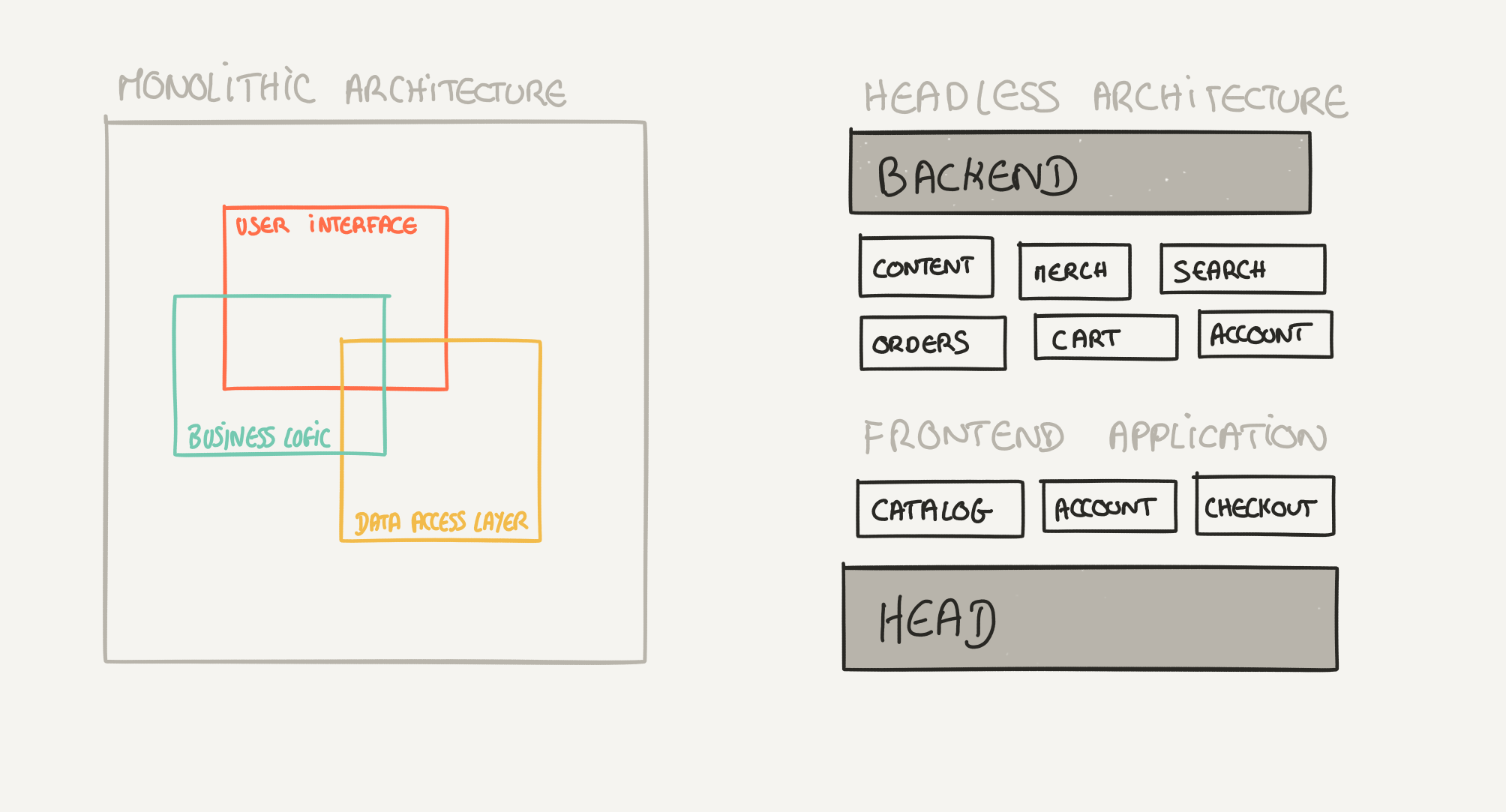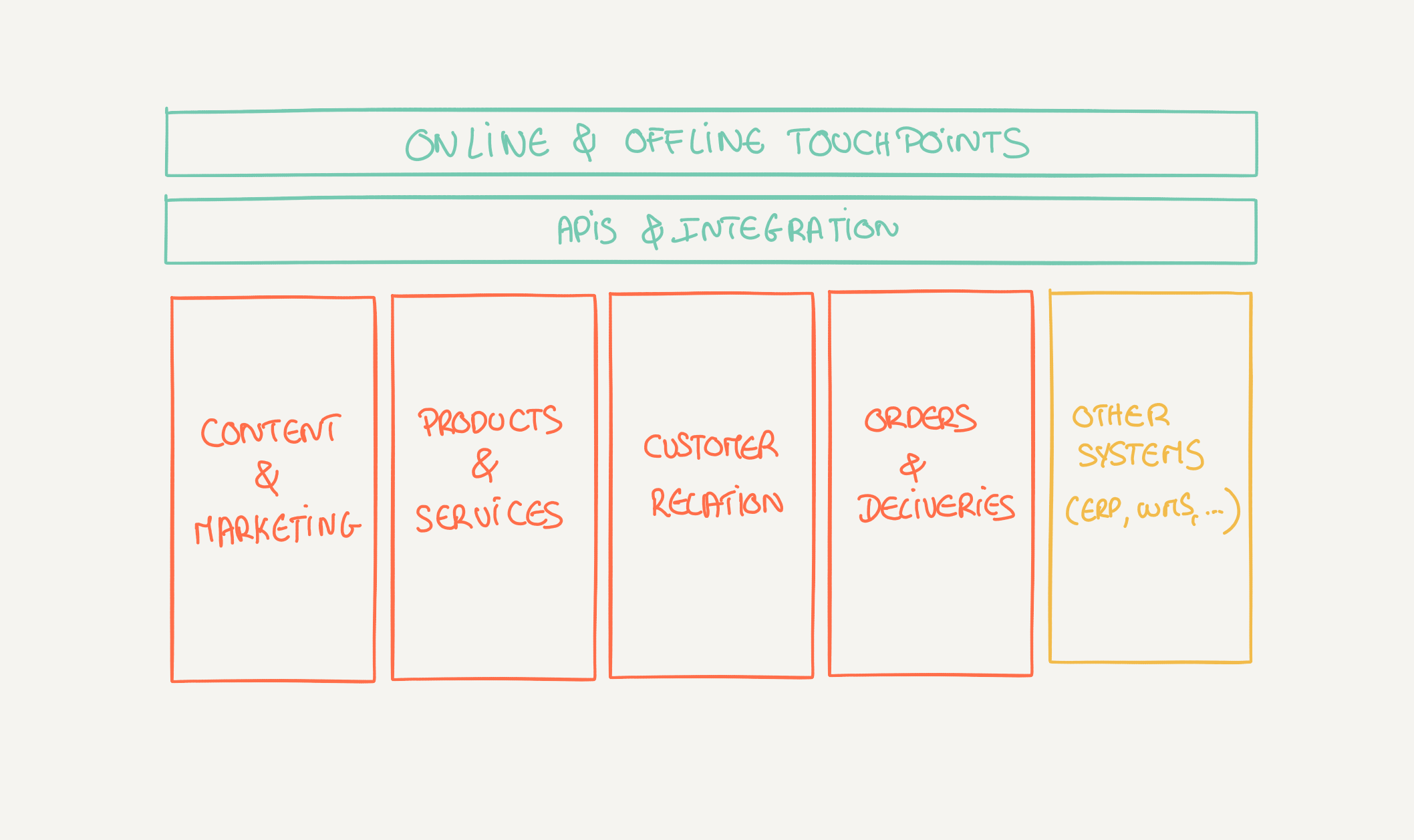Headless commerce

The eCommerce industry is full of challenges and the first one is the need to build a strong yet adaptive solution: robust to handle traffic peaks/seasonality and adaptive enough to provide a personalized interface to seduce the customer with a unique customer journey.
Solutions like Salesforce Commerce Cloud are at the top of a wave but customers are more and more frustrated with the “one-fits-all strategy” and want to move away from the success tax imposed by the licensing model.
Relying on monolithic solutions is now seen as a trade-off on performance and personalization, the modern approach is typically to integrate or build headless solutions based on serverless solutions.
As a result, we may observe a new wave of Commerce solutions emerging or previously isolated players assuming a more challenger role using a particular approach: headless commerce.
eCommerce maturity
Many of our clients are now mature and they are not looking at global platforms anymore but at expert components allowing them to target each of their clients in a special way with an expert solution.

Separating the head from the back eases the integration of specialized components but as a reminder splitting down a monolith into different services increases the technical debt and governance cost.
This separation of concern will ask you to consider where it’s important to invest in building custom solutions and where it’s just nice to have new features as a commodity.
It goes also for the B2B
As the customer journeys can evolve quickly, eCommerce teams have to be ready for changing all aspects of the contact point with your company: EDI paved the road, APIs are the new way of connecting services.
Headless commerce allows empowering all initiatives from local teams, partners, employees, by giving them controlled access to all corporate information through an API layer.
Thus according to the market, you can change the business logic without changing the user interface or API contract.

Experience first
The headless approach is an opportunity for retailers to focus and customize their frontend as their backend migrates to the cloud to become a commodity.
Process unification across channels
Allowing at the same time unification of business processes across channels: POS, Voice, Messenger, eCom, App relying on a global platform for their multiple channels.
Market such as China or Japan heavily rely on messenger apps like WeChat or Line and they require a headless commerce application to provide API in order to integrate the order fulfillment to those contact points. No need to say, it’s an upcoming trend for the European and American markets.
Performance is key
Allowing a significant performance improvement on the key pillars of an eCommerce platform:
-
operational performance with parallels streams of dedicated teams
-
technical performance (isolation, scaling)
-
business performance with and an increase of the conversion rate on every channel
Performance and time to interaction are key to increases conversion and retention. So imagine a category page loading in 30ms **instead of 1,5 seconds on your current e-commerce platform that is 50 times faster**. The static site allows better performance, SEO and scalability, it can sound stupid, but I think we forgot how blazingly fast the display of the static page is.
Existing actors
-
Adobe Magento Commerce now integrates GraphQL, PWA… and moves toward losing coupling.
-
Shopify was created API first, and many users use it in a headless way.
-
SalesForce Commerce is slowly moving toward API first approach, but it’s an important transition.
-
OroCommerce provides an API interface for B2B usage
-
Alternative emerges in this competitive market such as Commerce Layer or Big Commerce, Crystallize.
Headless Commerce key benefits are operational and technical improvements
-
Serving up-to-date data to all touchpoints and personalized customer journey with unique features
-
Improve the developer experience: Backend developers will specialize in their services and increase their production speeds, while frontend developers will be able to create new experiences easily by manipulating only the data they need.
-
Easing implementation of new services (customer reviews, recommendations, etc.), but also integration with IT systems (PIM, ERP, CRM…)
To summarize, headless commerce applications are great: they scale, they are fast and easy to distribute.
So retailers can now focus on two key activities: personalization of the customer experience solving complex problems they can meet with the best tools available.
Few examples of Headless Commerce


The project had an ambitious timeline of just 3 months for its design and implementation and needed to accommodate some very specific design requirements, as well as deliver an efficient shopping experience.

Do you have headless commerce?
-
Do you want to build a headless platform?
-
What components should you build?
-
What components should you buy?
-
Is your use case-ready, or do you need help demonstrating it?
We are here to help you build the future.
Coming next :
-
You are here — Part 1 — Headless commerce
-
Part 2 — Where do I start my journey to headless eCommerce?
-
Part 3 — I want my CDN application!
-
Part 4 — Legacy management and progressive migration
Authors
**Fabien Gasser — Innovation Advisor @ Smile Innovation dpt. **We explore, test, and recommend new technologies, creating new offers and value propositions for our clients.
We work on artificial intelligence focusing on conversational assistants and computer vision using service design.
**Jean-Charles Bordes — VP e-commerce @ Smile **With 15 years of XP and 300 projects, we support our customers in the business and operational performance of their activity.
Experienced explorers, we are the partner of the first projects or technically complex projects with high business stakes.